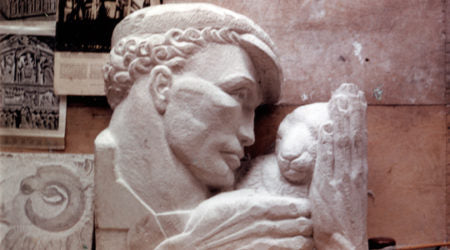The Heaton Cooper Studio, like many galleries around the world is celebrating International Sculpture Day (27th April), an annual global celebration of sculpture, established to raise awareness, appreciation and enjoyment of sculpture as an art form throughout the world.
We, however, have more reason than most to celebrate this exquisite art form as one of our family members excelled in this medium…

That family member was Ophelia Gordon Bell, the daughter of accomplished animal painter Winifred Gordon Bell. By her mid-teens Ophelia was well on her way to becoming an accomplished artist in her own right, studying at the Regent Street Polytechnic Sculpture School, London, where she learnt to work in a variety of materials, including stone, wood, metal, clay and plaster.

Like many sculptors Ophelia was fascinated by the origins of the art form… small sculptures as personal possessions are some of the earliest forms of prehistoric art, and the use of large statement sculptural pieces of as public art goes back at least 4,500 years…
If you simply take a little time and consider this question… what we would know of ancient cultures without sculpture?
From the cave carvings of the pre-historic to the works of the great masters, sculptural art has been the one consistent way we as humans have expressed ourselves throughout the ages. Before the written word, sculptural art was the main form of expression, conveying our beliefs and views on the world around us.
We make immediate associations to long-departed cultures through in the main the sculptural works they left behind, for example the ancient Egyptians and the Sphinx, the Chinese Emperors and the terracotta army, the Greeks with their love of the human form and the Romans elevating their rulers to become gods.

Sculpture by definition is three-dimensional art made by one of four basic processes: carving, modelling, casting, constructing.
It is quite simply the most enduring form art known to human kind, it has played a major role in the evolution of our culture. Perhaps it endures to this day as our main form of cultural expression and of memorial because of the unique way in which it expresses itself, unlike other art forms, it patiently waits for us to sit and experience the ideas it seeks to convey…

Sculpture comes to life through the play of light during the day, the surroundings in which the piece sits and because it is solid and usually three dimensional, which means we can interact and view it in any number of ways as a result. Viewing a sculpture is very different than seeing a flat painting hanging on a wall. You can walk around it, look through it, over it or into it.
The materials used in sculpture are diverse, including metal, stone and clay, with cheaper, less durable materials; including wood, bone and antler. Perhaps it is this diversity that appeals, the textures produce quite different visual effects according to whether they are convex or concave, flat or modelled, coloured or uncoloured.
This is why sculpture continues to play such an important role in human expression – Ophelia understood all of this better than most and used her knowledge to great effect to create a body of work utilising a broad range of natural materials that to this day inspires and intrigues the beholder…

